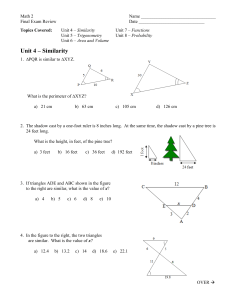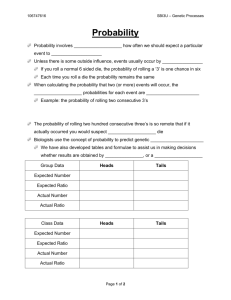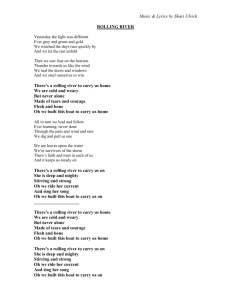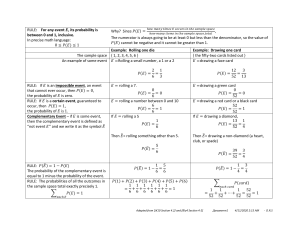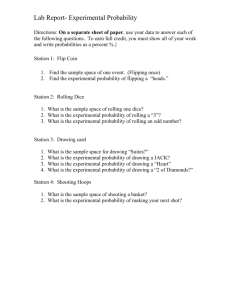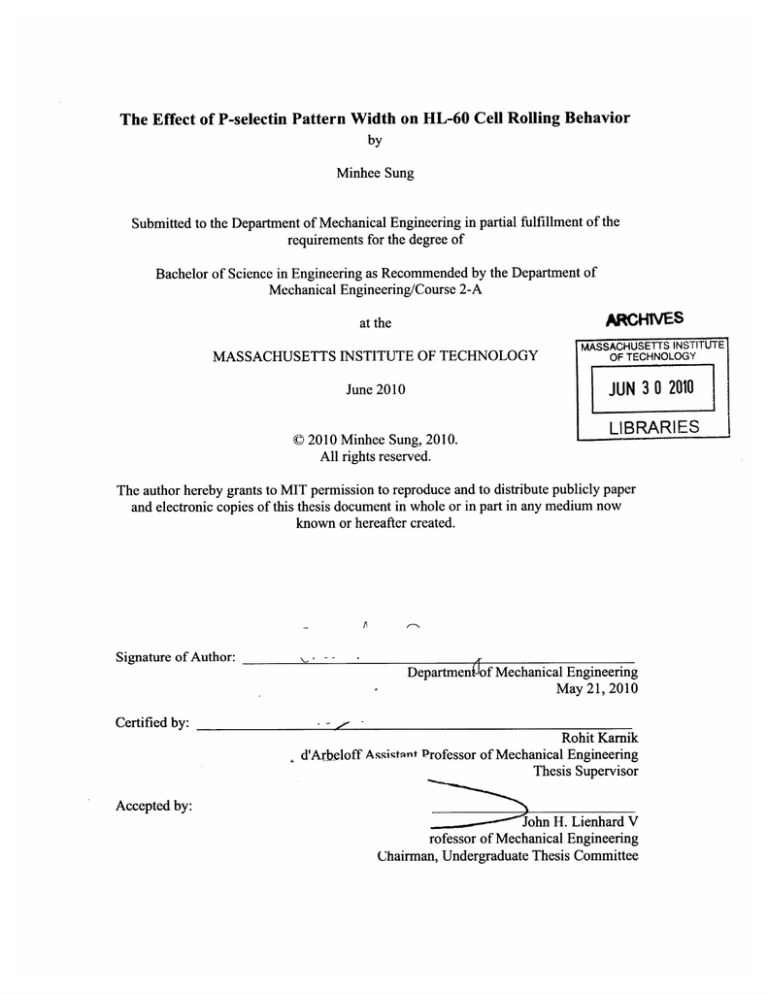
The Effect of P-selectin Pattern Width on HL-60 Cell Roling Behavior
by
Minhee Sung
Submitted to the Department of Mechanical Engineering in partial fulfillment of the
requirements for the degree of
Bachelor of Science in Engineering as Recommended by the Department of
Mechanical Engineering/Course 2-A
ARCHIVES
at the
MASSACHUSETTS INSTITUTE OF TECHNOLOGY
MASSACHUSETTS INSTITUTE
OF TECHNOLOGY
June 2010
JUN 3 0 2010
LIBRARIES
© 2010 Minhee Sung, 2010.
All rights reserved.
The author hereby grants to MIT permission to reproduce and to distribute publicly paper
and electronic copies of this thesis document in whole or in part in any medium now
known or hereafter created.
Signature of Author:
If
DepartmenJof Mechanical Engineering
May 21, 2010
Certified by:
Rohit Karnik
d'Arheloff Assitnnt Professor of Mechanical Engineering
Thesis Supervisor
Accepted by:
John H. Lienhard V
Engineering
of
Mechanical
rofessor
Chairman, Undergraduate Thesis Committee
THIS PAGE INTENTIONALLY LEFT BLANK
The Effect of P-selectin Pattern Width on HL-60 Cell Rolling Behavior
by
Minhee Sung
Submitted to the Department of Mechanical Engineering
on May 21, 2010 in partial fulfillment of the
requirements for the degree of
Bachelor of Science in Engineering as Recommended by the Department of
Mechanical Engineering/Course 2-A
Abstract
The effect of varying the width of P-selectin band patterns on the rolling behavior of HL60 myeloid cells along edges of the band patterns was studied. The P-selectin and
polyethylene glycol (PEG) pattern was produced via microcontact printing using a
polydimethylsiloxane (PDMS) stamp. HL-60 cells were flowed across the pattern using
a syringe pump at low and high volume flow rates, and the lengths of the cells' tracks
along the edge and velocities along the edge were obtained using a designed Matlab code.
It was found that on the 5ptm P-selectin band with patterns, the cells were moving
horizontally instead of along the edge because the patterns were too thin, while they were
rolling along the edge for the wider patterns. The 10ptm, 15ptm, and 20pm patterns
reflected the expected trend of resulting in increased track length along the edge with
increasing P-selectin widths. The 15pm band width corresponded to the highest rolling
velocities along the edge. The 5pm width gave the next to highest velocity which
resulted likely because the 5pm had the smallest P-selectin area to which the cells could
interact, except that the cells were not rolling along the edge at this width. In addition,
the 1Opm band width resulted in the lowest rolling edge velocity, which was unexpected.
As expected, the rolling velocities along the edge for the 10pjm and 15pm decreased
when the flow rate was increased because only the cells with the strongest adhesion
interactions remained on the patterns under higher shear stress. But the 5im and 20pm
patterns showed the opposite trend of decreasing with increasing flow rate. The
unexpected results suggest that there are still important considerations to be studied when
researching cell rolling behavior.
Thesis Supervisor: Rohit Karnik
Title: d'Arbeloff Assistant Professor of Mechanical Engineering
THIS PAGE INTENTIONALLY LEFT BLANK
Acknowledgements
The author would like to extend her utmost gratitude to Professor Rohit Karnik, ChiaHua Lee, and Suman Bose for their constant support and guidance throughout the
development of this thesis.
THIS PAGE INTENTIONALLY LEFT BLANK
TABLE OF CONTENTS
Abstract .........................................................................................................................
3
Acknowledgem ents.....................................................................................................
5
1 Introduction......................................................................................................
9
Experim ental M ethods.......................................................................................
11
2
3
2.1
M aterials ......................................................................................................
11
2.2
Microcontact Printing Stamp Fabrication.......................................................
11
2.3
Pattern Fabrication.........................................................................................
12
2.4
Cell Culture ..................................................................................................
13
2.5
Cell Rolling Experim ents..............................................................................
13
Data Analysis....................................................................................................
14
Cell Track Determination .............................................................................
14
3.2 Cell Track Analysis ......................................................................................
15
3.1
4 Results....................................................................................................................17
5
Discussion ..............................................................................................................
19
Average Track Length Along the Edge .........................................................
19
5.2 Average Rolling Velocity Along the Edge ....................................................
19
5.1
6 Conclusion .........................................................................................................
20
7 Bibliography .......................................................................................................
22
LIST OF FIGURES
Figure 1. Neutrophils rolling on endothelial cells via PSGL-1, P-selectin...............9
interactions 5
Figure 2. Images of the 5im, 10pm, 15pm, and 20pm P-selectin width patterns........12
and respective PEG widths of 30pm, 30pm, 35pm, and 40ptm.
Figure 3. Tracks of cells rolling on 5pm, lO m, 15pm, and 20pm ........................
P-selectin widths
14
Figure 4. Image before and after contrast correction......................................
15
Figure 5. Edges drawn by Matlab code using coordinates of two determined............16
edges on a 15pm P-selectin pattern
Figure 6. Average track length along the edge among varying P-selectin widths and... 18
flow rates
Figure 7. Average velocity along the edge among varying P-selectin widths and........18
flow rates
LIST OF TABLES
Table 1. Average track lengths at varying P-selectin widths and volume flow rates .... 17
Table 2. Average velocities along P-selectin edges (Vedge)..................................17
.....
..
....
.....
..
....
.......
I
..
..
..
.....
Introduction
Continuous flow cell separation techniques hold much importance in the field of medical
diagnostics. However the current methods of cell type separation using ligand-receptor
interactions involve many processing steps such as labeling of the cells and label
removal, which is not ideal for point-of-care diagnostics or for cells that are sensitive to
such processing'. In addition, developing countries do not have the luxury of having the
expensive equipment and materials needed for such processing. Therefore, an alternative
method of using receptor patterned surfaces for cell separation based on transient
adhesive receptor-ligand interactions of cells seems to be promising in that such methods
would require little processing steps with no need for labeling while retaining the
specificity provided by these interactions 2.
Cell rolling is the behavior in which cells form transient ligand-receptor bonds as they
flow past surfaces, usually in the blood stream along the walls of blood vessels (see
Figure 1). The ligand-receptor bonds dissociate readily and are easily broken by shear
stresses caused for instance by the flow of blood. This cell rolling behavior is primarily
mediated by glycoproteins called selectins. Leukocytes, neutrophils, metastatic cancer
cells, and hematopoietic stem cells make use of this rolling phenomenon to perform
important physiological functions, thereby making these cell types receptive to cell
separation via ligand-receptor interactions. For instance, leukocytes roll along vascular
endothelium to reach sites of inflammation and metastatic cancer cells use rolling to
reach secondary sites of tumor formation. 3
tood fow
-
0
Endotheflial ceN
Figure 1. Neutrophils rolling on endothelial cells via PSGL- 1,P-selectin interactions5 .
It has been shown that through surface patterning of receptors, specifically P-selectin, cell
rolling trajectories could indeed be directed via an edge effect in two dimensions 2 . The
cells used for study were HL-60 myeloid cells because these cells express a significant
quantity of P-selectin glycoprotein ligand- 1 (PSGL- 1), proteins that interact well with Pselectin ligands, making these HL-60 cells similar to leukocytes. When the HL-60 cells
encountered an angled edge of P-selectin patterning, a majority of them would follow the
edge at the angle to the horizontal fluid flow. Therefore, it seems promising to pursue the
application of cell rolling behavior for continuous flow cell separation. However, there
remain many questions that need to be answered in order to implement this technique
such as what is the optimal angle to promote the edge effect, do different cell types
exhibit different rolling behavior, and the question that is addressed in this paper: what is
the effect of P-selectin pattern width on the rolling behavior of cells? This study would
provide insight on the effect of P-selectin pattern width on rolling when the width is
comparable to the diameter of rolling cells.
In this study, HL-60 cells were used as a model for leukocyte rolling. HL-60 cells were
flowed at low (75pL/min) and high (300pL/min) flow velocities via a syringe pump
across a PEG (polyethylene glycol) and P-selectin angled pattern on gold-coated glass
slides. The high-definition pattern was produced by microcontact printing of selfassembling PEG molecules in order to block rolling on selected areas followed by
incubation of P-selection by physisorption 4 . The pattern contained four different Pselectin widths: 5pm, lOm, 15gm, and 20pm, with PEG gaps of 30im, 30p1m, 35pm,
and 4 0 gm respectively in between the P-selectin lines. The pattern was at an angle of 10
with respect to the direction of fluid flow. Image sequences were captured using a
camera mounted to a microscope, after which the images were analyzed using a Matlab
code to identify tracks and analyze them for track length and rolling velocity along the
edge 4 . The results were analyzed to study the effect of P-selectin band widths on cell
rolling behavior along an edge, which could give further insight and therefore headway in
producing a robust continuous flow cell separation technique.
2 Experimental Methods
2.1 Materials
Prior to use for experiments, the gold-coated glass slides (EMF Corp in Ithaca, NY) were
cleaned using piranha solution consisting of a 3:1 ratio of sulfuric acid to 30% hydrogen
peroxide in order to rid them of organic residue. The slides were then washed with pure
ethanol (EtOH; Pharmo-AAPER), then deionized (DI) water, ethanol again, and finally
dried with Nitrogen (N2) gas. (1-Mercaptoundec-11-yl)tetra(ethylene glycol), a PEG
alkanethiol, was diluted in pure ethanol to a 5 mM concentration prior to use in
microcontact printing and the recombinant human P-selectin (R&D Systems Inc.) was
diluted to 15 ptg/mL in IX Dulbeco's phosphate buffered saline or DPBS (Mediatech,
Inc.). The sulfuric acid, hydrogen peroxide, and PEG alkanethiol derivative were all
purchased from Sigma-Aldrich. The PEG alkanethiol, (1-Mercaptoundec- 11yl)tetra(ethylene glycol), will be referred to as "PEG".
2.2 MicrocontactPrinting Stamp Fabrication
The microcontact printings stamps were fabricated from polydimethylsiloxane (PDMS)
via a SU-8 molding process. The stamp consisted of four sections for the four different
P-selectin widths: 5pm, lOm, 15pm, and 20pm, and respective PEG widths of 30gm,
30ptm, 35pm, and 40pm (see Figure 2). The widths of the corresponding PEG lines for
each P-selectin width was chosen based on cell size and fabrication capabilities. All the
lines were at a 10* angle with respect to the horizontal. The angle was chosen based on
previous work that showed angles at such a range showed maximum cell deflection4 .
The stamp was stored in pure EtOH when not in use.
Figure 2. Images of the 5pm, 10gm, 15gm, and 20pm P-selectin width patterns and
respective PEG widths of 30gm, 30gm, 35pm, and 40gm. The light regions are the Pselectin and the dark regions are the PEG.
2.3 Pattern Fabrication
The PEG/P-selectin pattern was fabricated onto the gold slide via a two-step method,
where the first step consisted of inking the stamp with PEG, and the second step was
incubating the PEG pattern with P-selectin. For the first step, 5pM PEG solution (made
from 3.8gL PEG diluted in 200gL pure ethanol) was mixed by ultrasound and filtered
through a syringe filter. The stamp was inked with the PEG solution and dried for thirty
minutes. The piranha-cleaned gold slide was then stamped gently with the PEG-inked
stamp for thirty seconds, after which it was rinsed with EtOH, DI water and dried with N2
gas.
In the second step, the PEG pattern was subsequently incubated with 75pL of 15pg/mL
P-selectin for three hours using a sealed perfusion chamber, after which the gold slide
was cleaned several times with DPBS. Care was taken to make sure the pattern was wet
at all times with DPBS because drying out would ruin the P-selectin pattern. After
rinsing, the gold slide was then stored in a Petri dish filled with DPBS.
2.4 Cell Culture
The cells used for experiments were HL-60, human promyelocytic leukemia cells, which
were cultured in Dulbecco's Modified Eagle Medium within Invitrogen 75cm2 tissue
culture polysterene flasks. A cell concentration of about 105 cells/mL was maintained.
2.5 Cell Rolling Experiments
HL-60 cells (concentrated to about 106 cells per mL) were flowed across the PEG/Pselectin patterned gold slide using a rectangular flow chamber (Glycotech Inc.) of the
following dimensions: width = 1.0cm, length = 6 cm, thickness = 0.005 in. The cells
were flowed in via a 5mL syringe (diameter = 11.86 mm) and tubing using a
computerized syringe pump (Standard Infuse/Withdraw PHD Ultra Syringe Pump;
Harvard Apparatus), where volume flow rate was set at either 75pL/min or 300ptL/min,
where corresponding shear stresses are 0.5 dyn/cm 2 and 2 dyn/cm 2, respectively. The
gold slide was sealed to the flow chamber with a vacuum. A series of images of the cells
flowing past or rolling along the patterned surfaces were acquired via a camera (Andor
iXon 885) mounted to a microscope (Nikon TE2000-U) using a 4X objective. The
pictures were taken at about 1 frame per second for 300 seconds, giving a total of 300
images. Prior to each recording, cells were flowed in and allowed to settle onto the
patterned gold slide for three to five minutes to promote cell to selectin interaction. After
ample time for settling, the cells were then flown in at 75pL/min or 300pL/min, ten
seconds after which acquisition of the photos was started, so that the pictures were
capturing the overall cell rolling behavior, not the immediate effect from suddenly
starting an influx of cells. For each P-selectin width, experiments were run at least three
times, giving three different image sequences to be analyzed to ensure accuracy of
results.
3 Data Analysis
3.1 Cell Track Determination
A Matlab code (Mathworks Inc.) was developed by Suman Bose to analyze the sequence
of pictures taken in order to identify the tracks of the cells moving past the patterns. The
development of the tracking code is detailed in the Lee et al paper 4. The requirements for
a track was that the cells identified could not have moved more than 1Ojm (-diameter of
a cell) between consecutive frames and they had to be present in all the frames for the
given track (Figure 3). Such requirements eliminated illegitimate tracks of cells that
traveled to more than one patterned P-selectin line. Additionally, in order to eliminate
any random tracks, any tracks less than 100pm were removed.
0,
10pin P-selectmn width-
400 5im P-selectin width
-2W0
1
-3M
4C~
-7W
0
[
100
200
300
400
5W
600
700
O00
100
20
3
400
50
600
70
800
OW 1000
SW 1000
-
220 LLM' teetinwidth
-700.
-SSe
00
0 100
200
WO 40 WSM
0
7
00 OW W-2
0 I0c
-700-7
100S
00
6
600
700 OW0 Oc
1000
Figure 3. Tracks of cells rolling on 5 tm, 10m, 15pm, and 20prm P-selectin widths.
14
3.2 Cell Track Analysis
In order to determine the track length and velocity along the edge, the edge of the
patterns needed to be determined. The edge was defined for each image sequence by
adjusting the contrast of the first of the image series (Figure 4) so that the pattern became
visible and identifying two edges separated by at least ten gaps (Figure 5). The (x,y)
coordinates were found along each of the two edges, giving a total of four points. After
the edge determination, the code was written such that any tracks that ended within at
least 1pOgm of the four-point determined edge were retained. Additionally, any tracks that
were cut off by the field of view or existed before or after the image sequence was taken
were removed in order to ensure that the tracks retained were complete.
Figure 4. Image before and after contrast correction. a) Image before contrast correction
b) Image after contrast correction
The retained tracks could be separated into three categories: 1) tracks of cells that rolled
on the P-selectin region but not along the edge, 2) tracks of cells that began rolling in the
P-selectin region and then started to roll along the edge, and 3) tracks of cells that began
with rolling on the edge. The rolling velocity along the edge was computed by dividing
distance traveled along the edge by the time elapsed. The details of how the code was
written to actually calculate the velocity of rolling cells along the edge (Vedge) can be
found in the Lee et al paper. The length of the retained tracks was also determined.
-100
-
-200 -300
-
-400-
-500-600
~
-700
-800
-1000
0
100
200
300
400
500
600
700
800
900
1000
Figure 5. Edges drawn by Matlab code using coordinates of two determined edges on a
15pm P-selectin pattern. Two (x,y) coordinates for each edge and the number of gaps in
between the edges were determined and inputted into the Matlab code which drew the
remaining edges in between the chosen two.
4 Results
For each P-selectin width and flow velocity, experiments were run at least three to four
times. Averages of the track lengths and velocities of rolling cells in along the edge were
taken (Tables 1 - 2). Bar graphs were made of the data (Figures 6 - 7).
Table 1. Average track lengths at varying P-selectin widths and volume flow rates
Average Track Length at
Average Track Length at
P-selectin Width
pL/min flow rate (ptm)
300
(ptm)
rate
flow
75 pL/min
145.1574 17.5242
108.4723 12.9553
5 pm
10 pm
15 pm
20 pm
45.7947
52.6010
78.9163
11.1708
2.3971
8.1903
45.1437+ 1.6352
49.4754 + 6.8190
91.2778 + 24.3061
Table 2. Average velocities along P-selectin edges (Vedge)
Average Vedge at
Average Vedge at
P-selectin Width
75 pL/min flow rate (Im/s)
300 pL/min flow rate (pm/s)
5pm
10 pm
15 pm
2.2569 + 1.7087
1.1487 0.4609
3.3822 1.1352
2.6165
1.6512
3.4589
20 pm
1.6630 + 0.2099
2.8031 ± 0.2070
0.6642
0.5560
0.7846
.............
....
..
............
........
M75pL/min flow rate 0300pL/min flow rate
180 Ch
.2
a
160 -
- 140 -
120 -
c E 100
-
.a
80
I-
60 40 200
5
10
15
20
P-selectin Width (pm)
Figure 6. Average track length along the edge among varying P-selectin widths and flow rates.
I 75pL/min flow rate U 300pL/min flow rate
T-
5
Ch
.2
4.5
-
4-
3.5 -
u E
.0 3>4
Sa
0 uI
2.5
-
21.5
-
10.5
-
0-
----r-
5
10
15
20
P-selectin Width (pm)
Figure 7. Average velocity along the edge among varying P-selectin widths and flow rates.
5 Discussion
5.1 Average Track Length Along the Edge
For the 5pm P-selectin width patterns, the cells were primarily moving horizontally rather
than along the edge (see Figure 3) likely because the patterns had too little P-selectin area
to provide proper adhesion for edge rolling, whereas for the 1Opm, 15pm, and 20pm
patterns, the cells were rolling primarily along the pattern edges because there was
sufficient P-selectin area on which to roll. Therefore, if the 5pm width data is
disregarded because the cells were not rolling on the edge, there is an expected trend of
increasing average track length with increasing P-selectin width from 1Opm to 20pm
(Figure 6). This trend was the same for both volume flow rates of 75pl/min and
300g1/min. Interestingly, the edge lengths for the 15pm versus 20m P-selectin widths
are quite different from each other. We would expect the 15pm and 20pm widths to
show similar results because both widths are greater than the width of a cell, but instead
the 20pm has a far longer average edge length. This may have occurred because in the
experiments, the patterns for the 5pgm and 20pgm were more well-defined than the 10 im
and 15pm or there may be an unforeseen cell rolling behavior occurring at these widths.
5.2 Average Rolling Velocity Along the Edge
The bar graphs depicting the average rolling velocities along the edge among varying Pselectin pattern band widths (Figure 7) show that the 15pm width corresponds to the
greatest rolling velocity. One would expect the wider the P-selectin patterns, the lower
the rolling velocity because there is more selectin area to which the cells can interact
with. We do indeed see the next to highest rolling velocity from the 5pm pattern, which
can be explained by the fact that these patterns have the smallest area for cells to have
ligand-receptor interactions with, except as discussed earlier these cells were not rolling
on the edge. Also, the 10pim data corresponds to the lowest rolling velocity along the
edge. The 1Opm data can be incorrect because the stamped pattern was inconsistent
because there were splotches in the pattern being that it was difficult to achieve patterns
of such small widths.
The rolling velocities changed when the volume flow rate was increased from 75pL/min
to 300pL/min. At 300ptL/min, the 20pm instead of the 5gm P-selectin pattern now
corresponded to the second highest rolling velocity. The 15pm pattern still showed the
highest rolling velocity. It has been shown that higher shear stresses due to higher
volume flow rates led to lower rolling velocities because it is likely that at high shear
stresses, only cells that have the strongest adhesive interactions remain to roll on the
selectin 4 . This was further corroborated with the fact that under a 300PL/min flow rate,
most of the cells rolling on the patterns lost ligand-receptor interactions and flew off the
patterns due to the high shear stress. Therefore, there were far fewer cells rolling on
surfaces under 300pL/min than under 75pL/min. However, our data does not seem to
entirely show this trend. The rolling velocities for the 1Opm and 15pgm did decrease as
expected, but those of the 5ptm and 20pm increased instead. The reasons for these trends
in rolling velocities are unclear and may suggest rolling behaviors not yet considered.
6 Conclusion
The effect of P-selectin pattern band widths on the rolling behavior of HL-60 myeloid
cells were studied. On the 5im P-selectin band with patterns, the cells were moving
horizontally instead of along the edge because the patterns were too thin, while they were
rolling along the edge for the wider patterns. The 1Opm, 15pgm, and 20pm patterns
reflected the expected trend of resulting in increased track length along the edge with
increasing P-selectin widths. The 15pm band width corresponded to the highest rolling
velocities along the edge. The 5pm width gave the next to highest velocity which
resulted likely because the 5pm had the smallest P-selectin area to which the cells could
interact, except the cells were not rolling on an edge at this width. The 10 p0m band width
resulted in the lowest rolling edge velocity. As expected, the rolling velocities along the
edge for the 10pm and 15pm decreased when the flow rate was increased because only
the cells with the strongest adhesion interactions remained on the patterns under higher
shear stress. But the 5ptm and 20pm patterns showed the opposite trend of decreasing
with increasing flow rate.
These unexpected results suggest that there are still important considerations to be
studied when researching cell rolling behavior. To better understand the details of cell
rolling behavior, future work would include honing in a method to produce robust PDMS
stamps especially for the small width patterns and also including in the study the effect of
varying shear stresses along with the varying P-selectin widths. By pursuing such
research, a novel continuous flow, label-free cell separation device could be engineered,
one that could greatly impact the field of medical diagnostics.
7 Bibliography
[1] Radisic, Milica, Rohin K. Iyer, and Shashi K. Murthy. "Micro- and Nanotechnology
in Cell Separation." InternationalJournalofNanomedicine 1.1 (2006): 3-14.
[2] R. Karnik, S. Hong, H. Zhang, Y. Mei, D. G. Anderson, J. M. Karp and R. Langer,
Nano Letters, 2008, 8, 1153-1158.
[3] Krasik, Ellen F., and Daniel A. Hammer. "A Semianalytic Model of Leukocyte
Rolling." BiophysicalJournal87 (2004): 2919-2930.
[4] Lee, Chia-Hua, Suman Bose, Jeffery M. Karp, and Rohit Karnik. "Study of HL-60
Cell Rolling on Asymmetric P-Selectin Edges Fabricated By Microcontact
Printing." Lab Chip. 2010.
[5] McEver, Rodger P. "Rolling Back Neutrophil Adhesion." Nature Immunology 11
(2010): 282-284.

